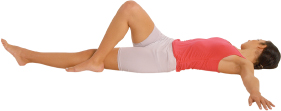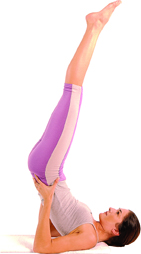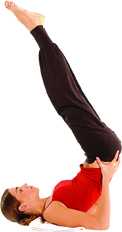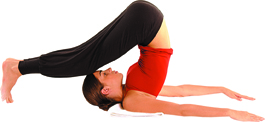Yoga, a moving philosophy
Calming the nervous system, relaxing body and mind and harmonizing emotional states are the three fundamental conditions needed to help prevent and relieve allergic reactions. Yoga helps us to attain these three objectives through the practice of certain postures or asanas.
+ The practice of yoga exercises (in Sanskrit) means practicing your body, spirit and your mind together. With yoga postures or asanas, the complete breathing and relaxation techniques of this ancient art becomes a powerful defense against allergies. The following asanas are recommended for allergic reactions.
THE FISH
This posture is highly beneficial for your body: it regulates thyroid and pineal gland functions and helps expand the ribcage fully, which is why its recommended for cases of asthma, sinus troubles and hay fever. It also relieves the stiffness of your neck and shoulder muscles and stretches your abdominals.
1. Sit on your heels, with your back straight, looking forward and with your hands on your thighs.

2. Breathing freely, bring your head all the way back, as you arch your spine. Rest your weight on your elbows and the palms of your hands.

3. Drop your head back so that the top of your head is on the floor. You should feel how your vertebrae press together and the area around your throat opens. When you are firmly placed in this position, bring your hands to your chest and place the palms of your hands together. Stay in this position for as long as you find comfortable. To come out of the pose, place your elbows on the floor, inhale, bring your chin to your chest and roll onto your side while you exhale.

LYING DOWN SPINAL TWIST
Other than stretching the legs and toning the spinal nerves, performing this pose also expands the ribcage fully, increases your lung capacity and aids in deep breathing when you have allergic attacks.
1. Lie on your back, your body straight, your legs stretched and your arms at your sides. Lift up your right leg and bring it to your chest, supporting it with your hands on your knee. Keep your leg like thiss for a few seconds and then repeat with your left leg.

2. Return to the initial position. Extend your left arm out at shoulder height. Inhale, and as you exhale bend your right leg and cross it over your stretched out left leg. Try to avoid lifting your right shoulder up from the floor. Stay in this position for a few minutes, while you concentrate on your breathing. Release and repeat on the other side.

THE CANDLE
This posture is recommended to help treat problems with asthma and bronchitis. It regulates the function of the thyroid glands and improves overall blood circulation.
1. From a lying position, with your arms extended next to your body, inhale and lift your legs until they form a 90 degree angle. Exhale, and when you inhale again lift up your hips and back, bringing your legs over your head.

2. Bend your arms, keep your hands back and bring your feet to the floor. Raise your left leg, streched (your chin needs to be pressed against your chest, so that your neck doesn't tense up).

3. Bring your right leg up, with your toes pointed to the ceiling and remain in this position as long as you can. Next, slowly lower your torso, bending your legs and placing each segment of your backbone against the floor.

PAY ATTENTION TO BREATHING
Achieving conscious breathing is one of the fundamental requisites of yoga technique. Without proper breathing you can't relax or concentrate, the conditions needed for practicing yoga poses.
THE PLOW
This pose helps to keep your back loose, to avoid spinal tension and stretch the sciatic nerve. Practicing this pose also improves blood circulation and fortifies the immune system; this is why it's recommended for allergic patients.
1. Begin the position lying on your back, with your legs together, arms down by your sides next to your body and palm of your hands pressed to the floor. Bring your chin toward your chest and press your back muscles to the floor. Inhale through your nose and exhale while you lift up both legs, until they are at a 90 degree angle with your torso. Exhale, then inhale and bring your hips off the floor, supporting your back with your hands.

2. Without bending your knees, stretch out your legs by bringing them behind your head, until your toes touch the floor. Your arms should stay forward, with the palms of your hands pressed to the floor. Stay in this position breathing slowly and deeply. Next, inhale through your nose and slowly lower your legs while you exhale. Concentrate on how each segment of your backbone presses against the floor as you come down.

GENTLE EXERCISE
Yoga is a discipline designed to improve your flexibility and your mental and emotional harmony. The exercises use gentle movements without straining the body. When practicing the asanas remember not to strain yourself. There is no need to push yourself too far. Remember to use gentle movements and don't push your body into a pose. Through time and willpower, you will improve your physical health naturally and get in tune with your body and mind. It is important to remember to use your body with moderation, patience and consistency to prevent side effects like sore muscles or tiredness.

Comment about this article, ask questions, or add new information about this topic: